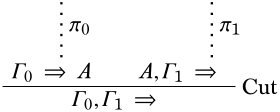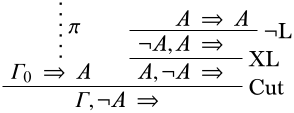8.9: Derivabilidad y consistencia
- Page ID
- 103665
\( \newcommand{\vecs}[1]{\overset { \scriptstyle \rightharpoonup} {\mathbf{#1}} } \)
\( \newcommand{\vecd}[1]{\overset{-\!-\!\rightharpoonup}{\vphantom{a}\smash {#1}}} \)
\( \newcommand{\id}{\mathrm{id}}\) \( \newcommand{\Span}{\mathrm{span}}\)
( \newcommand{\kernel}{\mathrm{null}\,}\) \( \newcommand{\range}{\mathrm{range}\,}\)
\( \newcommand{\RealPart}{\mathrm{Re}}\) \( \newcommand{\ImaginaryPart}{\mathrm{Im}}\)
\( \newcommand{\Argument}{\mathrm{Arg}}\) \( \newcommand{\norm}[1]{\| #1 \|}\)
\( \newcommand{\inner}[2]{\langle #1, #2 \rangle}\)
\( \newcommand{\Span}{\mathrm{span}}\)
\( \newcommand{\id}{\mathrm{id}}\)
\( \newcommand{\Span}{\mathrm{span}}\)
\( \newcommand{\kernel}{\mathrm{null}\,}\)
\( \newcommand{\range}{\mathrm{range}\,}\)
\( \newcommand{\RealPart}{\mathrm{Re}}\)
\( \newcommand{\ImaginaryPart}{\mathrm{Im}}\)
\( \newcommand{\Argument}{\mathrm{Arg}}\)
\( \newcommand{\norm}[1]{\| #1 \|}\)
\( \newcommand{\inner}[2]{\langle #1, #2 \rangle}\)
\( \newcommand{\Span}{\mathrm{span}}\) \( \newcommand{\AA}{\unicode[.8,0]{x212B}}\)
\( \newcommand{\vectorA}[1]{\vec{#1}} % arrow\)
\( \newcommand{\vectorAt}[1]{\vec{\text{#1}}} % arrow\)
\( \newcommand{\vectorB}[1]{\overset { \scriptstyle \rightharpoonup} {\mathbf{#1}} } \)
\( \newcommand{\vectorC}[1]{\textbf{#1}} \)
\( \newcommand{\vectorD}[1]{\overrightarrow{#1}} \)
\( \newcommand{\vectorDt}[1]{\overrightarrow{\text{#1}}} \)
\( \newcommand{\vectE}[1]{\overset{-\!-\!\rightharpoonup}{\vphantom{a}\smash{\mathbf {#1}}}} \)
\( \newcommand{\vecs}[1]{\overset { \scriptstyle \rightharpoonup} {\mathbf{#1}} } \)
\( \newcommand{\vecd}[1]{\overset{-\!-\!\rightharpoonup}{\vphantom{a}\smash {#1}}} \)
\(\newcommand{\avec}{\mathbf a}\) \(\newcommand{\bvec}{\mathbf b}\) \(\newcommand{\cvec}{\mathbf c}\) \(\newcommand{\dvec}{\mathbf d}\) \(\newcommand{\dtil}{\widetilde{\mathbf d}}\) \(\newcommand{\evec}{\mathbf e}\) \(\newcommand{\fvec}{\mathbf f}\) \(\newcommand{\nvec}{\mathbf n}\) \(\newcommand{\pvec}{\mathbf p}\) \(\newcommand{\qvec}{\mathbf q}\) \(\newcommand{\svec}{\mathbf s}\) \(\newcommand{\tvec}{\mathbf t}\) \(\newcommand{\uvec}{\mathbf u}\) \(\newcommand{\vvec}{\mathbf v}\) \(\newcommand{\wvec}{\mathbf w}\) \(\newcommand{\xvec}{\mathbf x}\) \(\newcommand{\yvec}{\mathbf y}\) \(\newcommand{\zvec}{\mathbf z}\) \(\newcommand{\rvec}{\mathbf r}\) \(\newcommand{\mvec}{\mathbf m}\) \(\newcommand{\zerovec}{\mathbf 0}\) \(\newcommand{\onevec}{\mathbf 1}\) \(\newcommand{\real}{\mathbb R}\) \(\newcommand{\twovec}[2]{\left[\begin{array}{r}#1 \\ #2 \end{array}\right]}\) \(\newcommand{\ctwovec}[2]{\left[\begin{array}{c}#1 \\ #2 \end{array}\right]}\) \(\newcommand{\threevec}[3]{\left[\begin{array}{r}#1 \\ #2 \\ #3 \end{array}\right]}\) \(\newcommand{\cthreevec}[3]{\left[\begin{array}{c}#1 \\ #2 \\ #3 \end{array}\right]}\) \(\newcommand{\fourvec}[4]{\left[\begin{array}{r}#1 \\ #2 \\ #3 \\ #4 \end{array}\right]}\) \(\newcommand{\cfourvec}[4]{\left[\begin{array}{c}#1 \\ #2 \\ #3 \\ #4 \end{array}\right]}\) \(\newcommand{\fivevec}[5]{\left[\begin{array}{r}#1 \\ #2 \\ #3 \\ #4 \\ #5 \\ \end{array}\right]}\) \(\newcommand{\cfivevec}[5]{\left[\begin{array}{c}#1 \\ #2 \\ #3 \\ #4 \\ #5 \\ \end{array}\right]}\) \(\newcommand{\mattwo}[4]{\left[\begin{array}{rr}#1 \amp #2 \\ #3 \amp #4 \\ \end{array}\right]}\) \(\newcommand{\laspan}[1]{\text{Span}\{#1\}}\) \(\newcommand{\bcal}{\cal B}\) \(\newcommand{\ccal}{\cal C}\) \(\newcommand{\scal}{\cal S}\) \(\newcommand{\wcal}{\cal W}\) \(\newcommand{\ecal}{\cal E}\) \(\newcommand{\coords}[2]{\left\{#1\right\}_{#2}}\) \(\newcommand{\gray}[1]{\color{gray}{#1}}\) \(\newcommand{\lgray}[1]{\color{lightgray}{#1}}\) \(\newcommand{\rank}{\operatorname{rank}}\) \(\newcommand{\row}{\text{Row}}\) \(\newcommand{\col}{\text{Col}}\) \(\renewcommand{\row}{\text{Row}}\) \(\newcommand{\nul}{\text{Nul}}\) \(\newcommand{\var}{\text{Var}}\) \(\newcommand{\corr}{\text{corr}}\) \(\newcommand{\len}[1]{\left|#1\right|}\) \(\newcommand{\bbar}{\overline{\bvec}}\) \(\newcommand{\bhat}{\widehat{\bvec}}\) \(\newcommand{\bperp}{\bvec^\perp}\) \(\newcommand{\xhat}{\widehat{\xvec}}\) \(\newcommand{\vhat}{\widehat{\vvec}}\) \(\newcommand{\uhat}{\widehat{\uvec}}\) \(\newcommand{\what}{\widehat{\wvec}}\) \(\newcommand{\Sighat}{\widehat{\Sigma}}\) \(\newcommand{\lt}{<}\) \(\newcommand{\gt}{>}\) \(\newcommand{\amp}{&}\) \(\definecolor{fillinmathshade}{gray}{0.9}\)Ahora estableceremos una serie de propiedades de la relación de derivabilidad. Son independientemente interesantes, pero cada uno jugará un papel en la prueba del teorema de integridad.
Si\(\Gamma \Proves A\) y\(\Gamma \cup \{A\}\) es inconsistente, entonces\(\Gamma\) es inconsistente.
Prueba. Hay finitos\(\Gamma_0\) y\(\Gamma_1 \subseteq \Gamma\) tales que\(\Log{LK}\) deriva\(\Gamma_0 \Sequent A\) y\(A, \Gamma_1 \Sequent \quad\). Que la\(\Log{LK}\) -derivación de\(\Gamma_0 \Sequent A\) ser\(\pi_0\) y la\(\Log{LK}\) -derivación de\(\Gamma_1, A \Sequent \quad\) ser\(\pi_1\). Entonces podemos derivar

Desde\(\Gamma_0 \subseteq \Gamma\) y\(\Gamma_1 \subseteq \Gamma\),\(\Gamma_0 \cup \Gamma_1 \subseteq \Gamma\), por lo tanto\(\Gamma\) es inconsistente. ◻
\(\Gamma \Proves A\)iff\(\Gamma \cup \{\lnot A\}\) es inconsistente.
Prueba. Primero supongamos\(\Gamma \Proves A\), es decir, hay una derivación\(\pi_0\) de\(\Gamma \Sequent A\). Al agregar una\(\LeftR{\lnot}\) regla, obtenemos una derivación de\(\lnot A, \Gamma \Sequent \quad\), es decir,\(\Gamma \cup \{\lnot A\}\) es inconsistente.
Si\(\Gamma \cup \{\lnot A\}\) es inconsistente, hay una derivación\(\pi_1\) de\(\lnot A, \Gamma \Sequent \quad\). La siguiente es una derivación de\(\Gamma \Sequent A\):

◻
Problema\(\PageIndex{1}\)
Demostrar que\(\Gamma \Proves \lnot A\) iff\(\Gamma \cup \{A\}\) es inconsistente.
Si\(\Gamma \Proves A\) y\(\lnot A \in \Gamma\), entonces\(\Gamma\) es inconsistente.
Prueba. Supongamos\(\Gamma \Proves A\) y\(\lnot A \in \Gamma\). Después hay una derivación\(\pi\) de un secuente\(\Gamma_0 \Sequent A\). El secuente también\(\lnot A, \Gamma_0 \Sequent \quad\) es derivable:

Desde\(\lnot A \in \Gamma\) y\(\Gamma_0 \subseteq \Gamma\), esto demuestra que\(\Gamma\) es inconsistente. ◻
Si\(\Gamma \cup \{A\}\) y ambos\(\Gamma \cup \{\lnot A\}\) son inconsistentes, entonces\(\Gamma\) es inconsistente.
Prueba. Hay conjuntos finitos\(\Gamma_0 \subseteq \Gamma\) y\(\Gamma_1 \subseteq \Gamma\) y\(\Log{LK}\) -derivaciones\(\pi_0\) y\(\pi_1\) de\(A, \Gamma_0 \Sequent \quad\) y\(\lnot A, \Gamma_1 \Sequent \quad\), respectivamente. Entonces podemos derivar

Desde\(\Gamma_0 \subseteq \Gamma\) y\(\Gamma_1 \subseteq \Gamma\),\(\Gamma_0 \cup \Gamma_1 \subseteq \Gamma\). De ahí\(\Gamma\) que sea inconsistente. ◻


